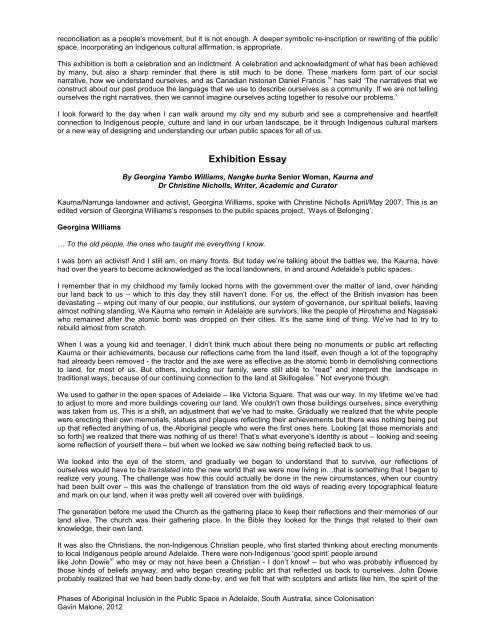Appendix A Ways of Belonging - Theses - Flinders University
Appendix A Ways of Belonging - Theses - Flinders University
Appendix A Ways of Belonging - Theses - Flinders University
Create successful ePaper yourself
Turn your PDF publications into a flip-book with our unique Google optimized e-Paper software.
econciliation as a people’s movement, but it is not enough. A deeper symbolic re-inscription or rewriting <strong>of</strong> the publicspace, incorporating an Indigenous cultural affirmation, is appropriate.This exhibition is both a celebration and an indictment. A celebration and acknowledgment <strong>of</strong> what has been achievedby many, but also a sharp reminder that there is still much to be done. These markers form part <strong>of</strong> our socialnarrative, how we understand ourselves, and as Canadian historian Daniel Francis iv has said ‘The narratives that weconstruct about our past produce the language that we use to describe ourselves as a community. If we are not tellingourselves the right narratives, then we cannot imagine ourselves acting together to resolve our problems.’I look forward to the day when I can walk around my city and my suburb and see a comprehensive and heartfeltconnection to Indigenous people, culture and land in our urban landscape, be it through Indigenous cultural markersor a new way <strong>of</strong> designing and understanding our urban public spaces for all <strong>of</strong> us.Exhibition EssayBy Georgina Yambo Williams, Nangke burka Senior Woman, Kaurna andDr Christine Nicholls, Writer, Academic and CuratorKaurna/Narrunga landowner and activist, Georgina Williams, spoke with Christine Nicholls April/May 2007. This is anedited version <strong>of</strong> Georgina Williams’s responses to the public spaces project, ‘<strong>Ways</strong> <strong>of</strong> <strong>Belonging</strong>’.Georgina Williams… To the old people, the ones who taught me everything I know.I was born an activist! And I still am, on many fronts. But today we’re talking about the battles we, the Kaurna, havehad over the years to become acknowledged as the local landowners, in and around Adelaide’s public spaces.I remember that in my childhood my family locked horns with the government over the matter <strong>of</strong> land, over handingour land back to us – which to this day they still haven’t done. For us, the effect <strong>of</strong> the British invasion has beendevastating – wiping out many <strong>of</strong> our people, our institutions, our system <strong>of</strong> governance, our spiritual beliefs, leavingalmost nothing standing. We Kaurna who remain in Adelaide are survivors, like the people <strong>of</strong> Hiroshima and Nagasakiwho remained after the atomic bomb was dropped on their cities. It’s the same kind <strong>of</strong> thing. We’ve had to try torebuild almost from scratch.When I was a young kid and teenager, I didn’t think much about there being no monuments or public art reflectingKaurna or their achievements, because our reflections came from the land itself, even though a lot <strong>of</strong> the topographyhad already been removed - the tractor and the axe were as effective as the atomic bomb in demolishing connectionsto land, for most <strong>of</strong> us. But others, including our family, were still able to “read” and interpret the landscape intraditional ways, because <strong>of</strong> our continuing connection to the land at Skillogalee. v Not everyone though.We used to gather in the open spaces <strong>of</strong> Adelaide – like Victoria Square. That was our way. In my lifetime we’ve hadto adjust to more and more buildings covering our land. We couldn't own those buildings ourselves, since everythingwas taken from us. This is a shift, an adjustment that we’ve had to make. Gradually we realized that the white peoplewere erecting their own memorials, statues and plaques reflecting their achievements but there was nothing being putup that reflected anything <strong>of</strong> us, the Aboriginal people who were the first ones here. Looking [at those memorials andso forth] we realized that there was nothing <strong>of</strong> us there! That’s what everyone’s identity is about – looking and seeingsome reflection <strong>of</strong> yourself there – but when we looked we saw nothing being reflected back to us.We looked into the eye <strong>of</strong> the storm, and gradually we began to understand that to survive, our reflections <strong>of</strong>ourselves would have to be translated into the new world that we were now living in…that is something that I began torealize very young. The challenge was how this could actually be done in the new circumstances, when our countryhad been built over – this was the challenge <strong>of</strong> translation from the old ways <strong>of</strong> reading every topographical featureand mark on our land, when it was pretty well all covered over with buildings.The generation before me used the Church as the gathering place to keep their reflections and their memories <strong>of</strong> ourland alive. The church was their gathering place. In the Bible they looked for the things that related to their ownknowledge, their own land.It was also the Christians, the non-Indigenous Christian people, who first started thinking about erecting monumentsto local Indigenous people around Adelaide. There were non-Indigenous ‘good spirit’ people aroundlike John Dowie vi who may or may not have been a Christian - I don’t know! – but who was probably influenced bythose kinds <strong>of</strong> beliefs anyway, and who began creating public art that reflected us back to ourselves. John Dowieprobably realized that we had been badly done-by, and we felt that with sculptors and artists like him, the spirit <strong>of</strong> thePhases <strong>of</strong> Aboriginal Inclusion in the Public Space in Adelaide, South Australia, since ColonisationGavin Malone, 2012















